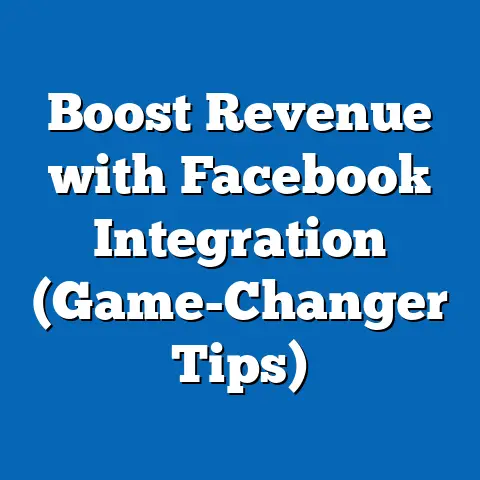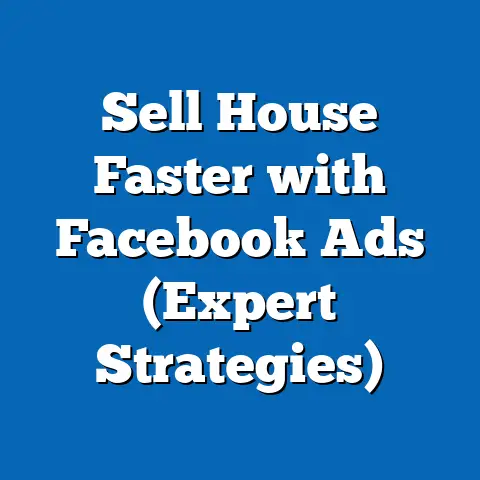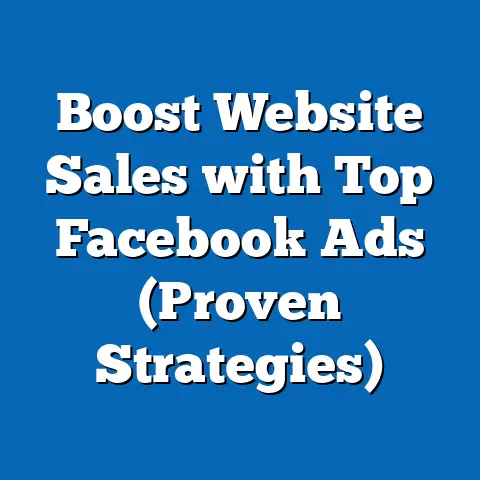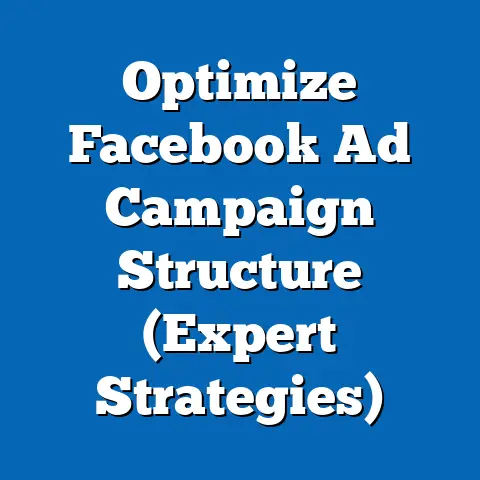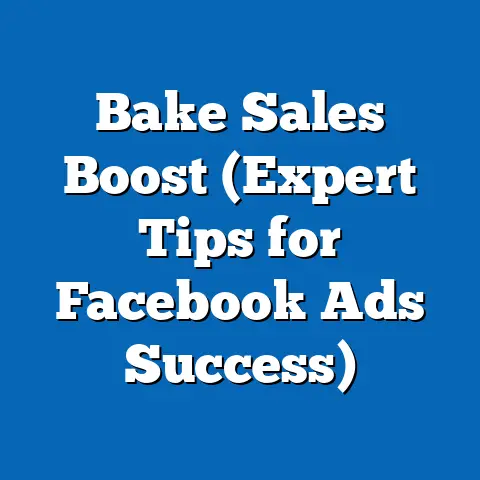Boost Business: Unlock Facebook Ads Success (Proven Strategies)
Have you ever watched a master craftsman at work? The way they meticulously select their materials, the precision with which they wield their tools, and the sheer artistry they pour into every detail is truly mesmerizing. That’s how I see successful Facebook advertisers – as modern-day artisans, crafting compelling campaigns that resonate with their audience and drive real business results. It’s not just about throwing money at ads; it’s about understanding your audience, crafting a compelling message, and continuously refining your approach. In this guide, I’ll share proven strategies to help you unlock Facebook Ads success and boost your business.
Section 1: Understanding the Facebook Ads Ecosystem
Before diving into the nitty-gritty, let’s lay a solid foundation by understanding the landscape.
1. Overview of Facebook Ads
Facebook Ads are, simply put, advertisements displayed on the Facebook and Instagram platforms (both owned by Meta). They’re a powerful tool for businesses to reach a vast audience, target specific demographics, and achieve various marketing objectives, from brand awareness to lead generation and sales.
Why are they so important? Well, consider this: Facebook boasts billions of active users. That’s a massive pool of potential customers. Beyond sheer numbers, Facebook’s sophisticated targeting capabilities allow you to pinpoint your ideal audience with incredible accuracy. Unlike traditional advertising, where you’re essentially broadcasting your message to everyone, Facebook Ads let you laser-focus on the people most likely to be interested in your products or services.
I’ve seen firsthand how a well-executed Facebook Ads campaign can transform a business. I worked with a local bakery struggling to attract new customers. By creating targeted ads showcasing their delicious treats and running them during peak hours, we saw a significant increase in foot traffic and online orders. It was a testament to the power of reaching the right people with the right message at the right time.
2. Target Audience Insights
Understanding your target audience is paramount to any successful marketing effort, and Facebook Ads are no exception. You can’t just assume you know who your ideal customer is; you need data to back it up.
Facebook offers a treasure trove of demographic data – age, gender, location, education, interests, behaviors, and more. This information allows you to create highly specific audience segments.
Why is this so crucial? Because generic ads rarely resonate. Imagine showing an ad for luxury watches to someone who primarily shops at discount stores – it’s a wasted impression. But if you target that ad to individuals who have shown interest in high-end brands, luxury goods, or watch collecting, you’re far more likely to capture their attention and drive a conversion.
I remember working with an e-commerce client selling eco-friendly cleaning products. Initially, their ads were targeted broadly at “environmentally conscious consumers.” While well-intentioned, the results were underwhelming. By digging deeper into Facebook’s data, we discovered that their ideal customers were primarily women aged 25-45, interested in organic food, sustainable living, and parenting. We refined our targeting accordingly, and the campaign’s performance skyrocketed.
Key Takeaway: Don’t rely on assumptions. Use Facebook’s audience insights to truly understand your target customer.
3. The Role of the Facebook Ads Manager
The Facebook Ads Manager is your command center for creating, managing, and analyzing your ad campaigns. It’s a comprehensive tool that provides everything you need to take your ads from conception to successful execution.
The interface can seem daunting at first, but don’t be intimidated. Think of it as a well-organized toolbox. It allows you to:
- Set up your campaigns: Define your campaign objective (e.g., brand awareness, website traffic, lead generation, sales).
- Define your target audience: Specify the demographics, interests, and behaviors you want to reach.
- Choose your ad placements: Select where you want your ads to appear (e.g., Facebook feed, Instagram feed, Audience Network).
- Set your budget and schedule: Determine how much you want to spend and when you want your ads to run.
- Create your ads: Design your visuals and write your ad copy.
- Track your results: Monitor key metrics like impressions, clicks, conversions, and ROI.
Setting up an ad campaign:
- Choose your objective: Start by defining what you want to achieve with your campaign. Are you trying to increase brand awareness, drive traffic to your website, generate leads, or make sales?
- Define your audience: Use Facebook’s targeting options to create a specific audience segment.
- Set your budget: Determine how much you want to spend daily or over the lifetime of the campaign.
- Choose your ad placements: Select where you want your ads to appear.
- Create your ad: Design your visuals and write your ad copy.
I’ve seen businesses achieve remarkable results simply by mastering the basics of the Ads Manager. Take the case of a small fitness studio. They used the Ads Manager to target potential clients within a 5-mile radius of their location, offering a free introductory class. The campaign was simple, but highly effective, resulting in a surge of new sign-ups.
Key Takeaway: Familiarize yourself with the Facebook Ads Manager. It’s your key to unlocking the full potential of Facebook advertising.
Next Steps:
- Explore the Facebook Ads Manager interface.
- Create a test campaign with a small budget to get a feel for the platform.
- Experiment with different targeting options to see what works best for your audience.
Section 2: Crafting Effective Ad Content
Now that you understand the basics of the Facebook Ads ecosystem, let’s focus on the heart of your campaign: the ad content itself.
1. The Power of Storytelling
In a world saturated with advertisements, storytelling is what sets your ads apart. People are drawn to stories. They remember them, they connect with them, and they share them.
Instead of simply listing the features of your product or service, weave a narrative that resonates with your audience’s emotions, aspirations, or challenges. Show how your product or service solves a problem, improves lives, or helps people achieve their goals.
Consider the success of Dove’s “Real Beauty” campaign. It wasn’t about selling soap; it was about challenging conventional beauty standards and celebrating the diversity of women. This resonated deeply with women around the world, leading to increased brand loyalty and sales.
Another great example is Airbnb’s “Belong Anywhere” campaign. It focused on the human connection fostered through travel and the feeling of belonging in new places. This powerful storytelling tapped into people’s desire for authentic experiences, driving significant growth for the platform.
Key Takeaway: Tell stories that connect with your audience on an emotional level.
2. Visual Elements and Design
In the fast-paced world of social media, visuals are king. Your images and videos are the first thing people see, and they need to grab attention instantly.
Here are some design tips to consider:
- Use high-quality images and videos: Blurry or pixelated visuals are a major turn-off. Invest in professional photography or videography if possible.
- Keep it simple: Avoid cluttered designs. Focus on a clear message and a strong focal point.
- Use contrasting colors: Make your visuals stand out from the background.
- Optimize for mobile: Most people will see your ads on their smartphones, so ensure your visuals are optimized for smaller screens.
- A/B test your visuals: Experiment with different images and videos to see what resonates best with your audience.
I’ve seen ads with amazing copy fall flat simply because the visuals were subpar. On the other hand, I’ve seen simple ads with compelling visuals generate incredible results. It’s a delicate balance, but the visuals are often the first impression, so make them count.
Key Takeaway: Invest in high-quality visuals that capture attention and communicate your message effectively.
3. Compelling Copywriting Techniques
Your ad copy is your opportunity to persuade your audience to take action. It needs to be clear, concise, and compelling.
Here are some proven copywriting strategies:
- Focus on benefits, not features: Tell people how your product or service will improve their lives.
- Use strong verbs and active voice: Create a sense of urgency and excitement.
- Address your audience’s pain points: Show that you understand their challenges and offer a solution.
- Use social proof: Include testimonials, reviews, or case studies to build trust.
- Keep it short and sweet: People have short attention spans, so get to the point quickly.
The importance of a strong call-to-action (CTA):
Your CTA is the final nudge that encourages people to take action. It needs to be clear, concise, and relevant to your offer.
Examples of effective CTAs:
- “Shop Now”
- “Learn More”
- “Sign Up”
- “Get Started”
- “Download Now”
I once worked with a client who had great visuals and compelling copy, but their ads weren’t converting. The problem? Their CTA was weak and ambiguous. We changed it from “Click Here” to “Get Your Free Ebook Now,” and the conversion rate tripled.
Key Takeaway: Craft compelling ad copy that focuses on benefits, addresses pain points, and includes a strong CTA.
Next Steps:
- Brainstorm story ideas for your ads.
- Experiment with different visual styles and design elements.
- Practice writing compelling ad copy that focuses on benefits and includes a strong CTA.
Section 3: Strategic Targeting Techniques
Targeting is where Facebook Ads truly shine. It’s the ability to reach the right people with the right message that makes them so effective.
1. Utilizing Facebook’s Targeting Options
Facebook offers a wide range of targeting options, including:
- Location: Target people based on their geographic location (country, state, city, zip code).
- Demographics: Target people based on their age, gender, education, relationship status, and more.
- Interests: Target people based on their interests, hobbies, and passions.
- Behaviors: Target people based on their online and offline behaviors, such as purchase history, travel habits, and device usage.
- Custom Audiences: Target people based on your existing customer data, such as email lists, website visitors, or app users.
- Lookalike Audiences: Target people who are similar to your existing customers.
Custom Audiences:
Custom Audiences are incredibly powerful. They allow you to target people who have already interacted with your business, making them more likely to convert.
For example, you can create a Custom Audience of people who have visited your website in the past 30 days. This allows you to retarget them with ads that are relevant to the pages they visited.
Lookalike Audiences:
Lookalike Audiences are another game-changer. They allow you to reach new people who are similar to your existing customers.
Facebook analyzes your Custom Audience and identifies the common characteristics and behaviors of its members. It then finds other people on Facebook who share those same characteristics and behaviors.
Key Takeaway: Leverage Facebook’s targeting options to reach the right people with the right message.
2. Retargeting Strategies
Retargeting is the art of showing ads to people who have already interacted with your business but haven’t yet converted. It’s a highly effective strategy for driving sales and generating leads.
People often need to see your message multiple times before they’re ready to take action. Retargeting allows you to stay top-of-mind and nurture them towards a conversion.
Setting up retargeting campaigns:
- Create a Custom Audience of website visitors: Install the Facebook Pixel on your website to track visitor behavior.
- Create a retargeting ad: Design an ad that is relevant to the pages they visited or the actions they took on your website.
- Target your Custom Audience: Select your Custom Audience as the target audience for your retargeting ad.
I’ve seen retargeting campaigns generate incredible ROI. One client, an online clothing retailer, saw a 300% increase in sales after implementing a retargeting strategy. They showed ads to people who had abandoned their shopping carts, reminding them of the items they had left behind.
Key Takeaway: Implement retargeting campaigns to nurture leads and drive conversions.
3. A/B Testing for Optimization
A/B testing, also known as split testing, is the process of comparing two versions of an ad to see which one performs better. It’s an essential technique for refining your ad campaigns and maximizing your ROI.
What elements to test:
- Headlines: Test different headlines to see which one grabs attention more effectively.
- Visuals: Test different images and videos to see which ones resonate best with your audience.
- Ad copy: Test different ad copy to see which one drives more clicks and conversions.
- CTAs: Test different CTAs to see which one encourages people to take action.
- Targeting: Test different targeting options to see which ones reach the most qualified leads.
How to analyze results:
- Track key metrics: Monitor metrics like impressions, clicks, conversions, and ROI.
- Use statistical significance: Ensure that your results are statistically significant before making any changes.
- Focus on incremental improvements: Small changes can often lead to significant improvements in performance.
I’m a huge advocate for A/B testing. It’s the only way to know for sure what works and what doesn’t. I’ve seen campaigns transformed by simply testing different headlines or visuals.
Key Takeaway: A/B test your ads to continuously refine your campaigns and maximize your ROI.
Next Steps:
- Create Custom Audiences and Lookalike Audiences.
- Set up retargeting campaigns for your website visitors.
- Start A/B testing your ads to optimize performance.
Section 4: Budgeting and Ad Spend Management
Understanding how to budget and manage your ad spend is crucial for maximizing your ROI. It’s not just about spending money; it’s about spending it wisely.
1. Understanding Facebook Ad Budgets
Facebook offers two main types of budgets:
- Daily Budget: The average amount you’re willing to spend each day.
- Lifetime Budget: The total amount you’re willing to spend over the entire duration of the campaign.
Determining the right budget:
The right budget depends on several factors, including:
- Your campaign objective: Brand awareness campaigns typically require lower budgets than conversion campaigns.
- Your target audience: Reaching a larger audience will require a higher budget.
- Your industry: Some industries are more competitive than others, requiring higher bids to reach your target audience.
- Your ROI goals: Determine how much you’re willing to spend to acquire a customer.
I often advise clients to start with a small budget and gradually increase it as they see positive results. This allows them to test different strategies and optimize their campaigns without risking too much money.
Key Takeaway: Choose the right budget based on your campaign objective, target audience, industry, and ROI goals.
2. Bidding Strategies
Facebook offers several bidding options, including:
- Lowest Cost: Facebook will automatically bid to get you the most results for your budget.
- Cost Per Result Goal: You set a target cost per result, and Facebook will bid to achieve that goal.
- Manual Bidding: You set your own bids for each auction.
Optimizing bids to maximize ROI:
The best bidding strategy depends on your campaign objective and your level of experience.
If you’re new to Facebook Ads, I recommend starting with the “Lowest Cost” option. This allows Facebook to automatically optimize your bids and get you the most results for your budget.
As you gain more experience, you can experiment with the “Cost Per Result Goal” or “Manual Bidding” options to gain more control over your bids.
Key Takeaway: Choose the right bidding strategy based on your campaign objective and your level of experience.
3. Monitoring and Adjusting Ad Spend
Monitoring your ad performance is crucial for ensuring that you’re getting the most out of your budget.
Techniques for monitoring ad performance:
- Track key metrics: Monitor metrics like impressions, clicks, conversions, and ROI.
- Use Facebook Analytics: Facebook Analytics provides in-depth insights into your audience’s behavior and engagement.
- Set up custom reports: Create custom reports to track the metrics that are most important to you.
Adjusting budgets accordingly:
Based on your performance data, you can adjust your budgets to maximize your ROI.
- Increase budgets for high-performing campaigns: If a campaign is generating positive results, increase the budget to reach a larger audience.
- Decrease budgets for low-performing campaigns: If a campaign is not generating positive results, decrease the budget or pause the campaign altogether.
- Reallocate budgets to better-performing ads: If some ads are performing better than others, reallocate your budget to those ads.
I’ve seen businesses significantly improve their ROI by simply monitoring their ad performance and adjusting their budgets accordingly. It’s an ongoing process of testing, analyzing, and optimizing.
Key Takeaway: Monitor your ad performance and adjust your budgets accordingly to maximize your ROI.
Next Steps:
- Choose the right budget for your campaign.
- Experiment with different bidding strategies.
- Monitor your ad performance and adjust your budgets accordingly.
Section 5: Measuring Success and Analyzing Results
Measuring your success and analyzing your results is critical for understanding what’s working and what’s not. It’s the foundation for continuous improvement.
1. Key Performance Indicators (KPIs)
KPIs are the metrics you use to measure the success of your Facebook ad campaigns.
Essential KPIs:
- Impressions: The number of times your ad was displayed.
- Reach: The number of unique people who saw your ad.
- Clicks: The number of times people clicked on your ad.
- Click-Through Rate (CTR): The percentage of people who clicked on your ad after seeing it.
- Conversions: The number of people who took the desired action after clicking on your ad (e.g., making a purchase, signing up for a newsletter).
- Cost Per Conversion (CPC): The cost of each conversion.
- Return on Ad Spend (ROAS): The revenue generated for every dollar spent on advertising.
Interpreting these metrics:
- High Impressions, Low Reach: Your ad is being shown to the same people repeatedly. Consider expanding your targeting.
- High Reach, Low Clicks: Your ad is reaching a lot of people, but it’s not compelling enough to get them to click. Improve your visuals or ad copy.
- High Clicks, Low Conversions: People are clicking on your ad, but they’re not taking the desired action on your website. Improve your landing page or offer.
- High CPC, Low ROAS: Your cost per conversion is too high, and you’re not generating enough revenue to justify your ad spend. Optimize your targeting, bidding, or ad creative.
I always tell my clients to focus on the metrics that matter most to their business goals. If you’re trying to generate leads, focus on the number of leads generated and the cost per lead. If you’re trying to drive sales, focus on the number of sales generated and the ROAS.
Key Takeaway: Define essential KPIs and track them regularly to measure the success of your Facebook ad campaigns.
2. Utilizing Facebook Insights
Facebook Insights provides in-depth analysis of your audience engagement and ad effectiveness. It’s a powerful tool for understanding how people are interacting with your ads and your brand.
Analyzing audience engagement:
- Demographics: See the age, gender, location, and other demographics of the people who are engaging with your ads.
- Interests: See the interests and hobbies of the people who are engaging with your ads.
- Behaviors: See the online and offline behaviors of the people who are engaging with your ads.
Analyzing ad effectiveness:
- Performance metrics: Track key metrics like impressions, reach, clicks, conversions, and ROI.
- Ad creative analysis: See which visuals and ad copy are performing best.
- Placement analysis: See which ad placements are generating the most results.
Adjusting strategy based on insights gained:
Use the insights you gain from Facebook Insights to adjust your strategy and improve your results.
- Refine your targeting: Target the demographics, interests, and behaviors that are most likely to engage with your ads.
- Optimize your ad creative: Use the visuals and ad copy that are performing best.
- Adjust your ad placements: Focus on the ad placements that are generating the most results.
I’ve seen businesses completely transform their Facebook advertising strategy by simply paying attention to the insights provided by Facebook Insights. It’s a goldmine of information that can help you understand your audience and optimize your campaigns.
Key Takeaway: Use Facebook Insights for in-depth analysis of audience engagement and ad effectiveness.
3. Long-term Strategies for Continued Success
Facebook advertising is not a one-and-done activity. It’s an ongoing process of testing, analyzing, and optimizing.
Strategies for maintaining momentum:
- Stay up-to-date with the latest trends: Facebook is constantly evolving, so it’s important to stay up-to-date with the latest trends and best practices.
- Continuously test new strategies: Don’t be afraid to experiment with new targeting options, ad formats, and bidding strategies.
- Engage with your audience: Respond to comments and messages promptly and professionally.
- Build a community: Create a Facebook group or page where you can connect with your audience and build relationships.
- Track your results and adjust your strategy accordingly: Continuously monitor your performance and make adjustments as needed.
The importance of continual learning and adaptation:
The world of digital marketing is constantly changing, so it’s important to be a lifelong learner. Read industry blogs, attend webinars, and network with other marketers to stay ahead of the curve.
I’ve seen businesses that were once successful with Facebook advertising fall behind because they failed to adapt to the changing landscape. Don’t let that happen to you.
Key Takeaway: Maintain momentum by staying up-to-date with the latest trends, continuously testing new strategies, and engaging with your audience.
Next Steps:
- Define essential KPIs for your business.
- Use Facebook Insights to analyze your audience engagement and ad effectiveness.
- Develop long-term strategies for continued success.
Conclusion: The Mastery of Facebook Advertising
Unlocking Facebook Ads success is not just about following a set of instructions; it’s about embracing the principles of craftsmanship. It’s about paying attention to detail, being creative, and thinking strategically. It’s about understanding your audience, crafting compelling messages, and continuously refining your approach.
The journey may be challenging, but the rewards of increased brand visibility and business growth make it a worthy pursuit. So, embrace the challenge, hone your skills, and unlock the full potential of Facebook advertising.

